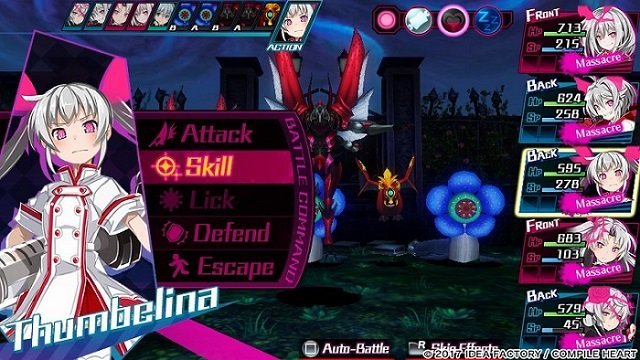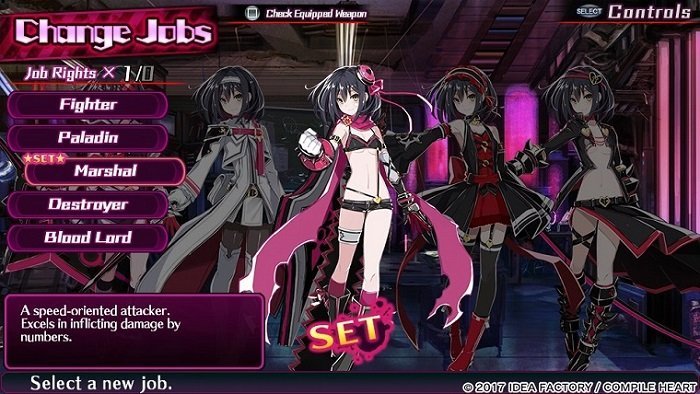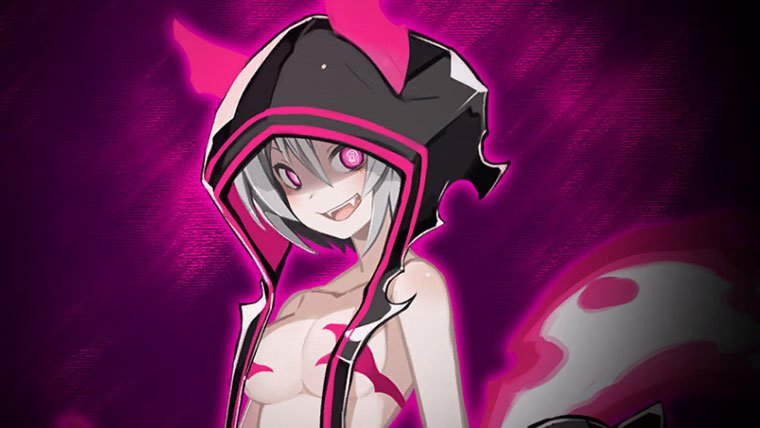One of the most defining characteristics of Compile Heart is that it is never does the same thing twice. Yes, there will be some commonality between a few games within the same genre or series, but the company always strives to have each new game it creates surpass the one in the same genre that came before it. It has been doing so for years now, but Mary Skelter: Nightmares is easily the strongest example of that practice yet.
Mary Skelter: Nightmares takes everything Compile Heart has learned from titles such as MeiQ: Labyrinth of Death and Moe Chronicle, as well as incorporate features from other well known dungeon crawlers such as Etrian Odyssey and Dungeon Travelers 2 to offer one of its most unique and memorable experiences to date.
Now don’t get me wrong, all the hallmarks of a Compile Heart game is present in Mary Skelter: Nightmares: interesting setting, fantastic art, a diverse cast, unique mechanics and, of course, fanservice; however, even those might not be executed in the way you might expect.

Right off the bat, Compile Heart stays true to form with the story, which, as is usually the case, begins intriguing and simple but becomes more complicated as time goes on.
Mary Skelter: Nightmares tells the story of two childhood friends, Jack and Alice, who are imprisoned in a living prison called Jail which suddenly appeared a few years before the game begins (an accompanying novel offers more details). After being rescued by Red Riding Hood who is a member of an organization called the Dawn, they find themselves taking up residence within a small compound of freed people called the Liberated District. From there they join with other members of the Dawn, such as Snow White, Cinderella and Kaguya (see the common theme yet?) in an attempt to escape Jail and earn their freedom.
As mentioned before, things do become more complicated as things go along. It becomes clear fairly quickly that not everything is as it seems and while a few of your party members do catch on and raise some concerns, the ending doesn’t do an entirely good job at putting all of them to rest.
Fortunately, while the story may falter, the characters remain entertaining the entire way through.

As mentioned in the preview, all of the main characters are inspired by a character from a famous fairy tale/novel/etc. and various aspects of their personalities or back stories are dictated by their base material. For example, Kaguya is lazy and has you collect the five treasures featured in The Tale of the Bamboo Cutter, while Snow White has little self-confidence and is so scared of mirrors that she can’t even manage to look at her own reflection. Though each of them will grow and mature throughout the course of the game, they’re greatest amount of growth can only experienced if you’re willing to have Jack spend time with each heroine by raising their affection. If you do, you’ll unlock a series of events where Jack will steadily help them surpass their namesake (for example, Snow White comes to understand her good points and becomes able to look in a mirror) and grow as characters.
Just like with the characters, Mary Skelter: Nightmares also does a good job with the hallmarks of a dungeon crawler — exploration, character progression and battle — offering new approaches to each.
Exploration in Mary Skelter: Nightmares is conducted in teams of six: Jack and five party members, also known as Blood Maidens, of your choosing. Each dungeon is unique, possessing a motif inspired by a fairy tale or novel (for example, the Graveyard features thorns, roses and dwarves as pictured in Snow White and Sleeping Beauty, while the Dorm is laden with the same candy that was featured in Hansel & Gretel) but the objective is the same with each: make your way to the dungeon’s depths and destroy the core residing within.

However, what makes these dungeons special compared to ones seen in other games is the fact that they’re alive and every step you take serves is a reminder of this fact. Not only are sights such as an exposed eye tracking your movements or an intestine that can be sliced open to obtain treasure commonplace, but a core mechanic of exploration is trying to fulfill the dungeon’s desires — hunger, lust and sleep — by doing specific actions in and out of battle, such as finding heart-shaped icons or completing a battle without getting hurt. There aren’t any penalties for not fulfilling them, but there are plenty of benefits for doing so, such as treasure, health recovery and even new section being added to the current area you’re in.
You’ll be spending a lot of time navigating through each dungeon’s halls as you work your way to its core, so it’s inevitable that you will be coming across a multitude of enemies along the way. Battles are conducted in the usual turn-based manner, pitting your party of five, along with Jack, against a varying amount of enemies. Most actions that each Blood Maiden will take is dictated by their current job, but Jack will always function as their support. For the most part, there are three actions he can take: taking damage in place of one of the girls for one turn, using an item or squirting one of the party members with his blood. The first option is negligible and can be safely ignored (even on Horror difficulty) and his items, though still useful, aren’t as effective as when an Item Meister uses them. However, his ability to squirt blood on other party members is his most important function because of the game’s signature blood mechanic.

As fights progress your party members will become increasingly covered in the blood of their enemies and a meter telling you how much of that blood is on any one of them can be seen right below her portrait. You can deplete that gauge by licking the blood off to gain temporary bonuses in the form of health restoration or stat boosts, or allow it to fill completely to induce one of two transformation states, Massacre or Blood Skelter mode, both of which offer increased stats and a set of new powerful attacks. What separates these two forms, however, is that you have control over a Blood Maiden in Massacre mode, whereas one in Blood Skelter mode will attack any target whether they’re friend or foe.
Even just one character in Blood Skelter mode can lead to a game over, so you need to prevent them from entering it at all and this is where Jack’s blood comes into play. Just like how damaging enemies covers a character in blood, receiving large amounts of damage causes them to build up Corruption — a metric that is also tracked on the blood meter. The darker the blood meter gets, the more Corruption the corresponding character has accumulated; and the chances of entering Blood Skelter mode rises as the blood meter becomes darker in color. Jack can use his blood to purge any and all Corruption from one party member, thus making it safe for them to build up blood without fear of consequence. That said, his usage of blood isn’t free and you’ll need to spend a turn or two replenishing it, lest you risk him knocking himself out and having him be unable to use items or more blood when you really need him.
If you manage to properly balance blood and Corruption as you defeat your enemies, you’ll be rewarded with the typical money, items and experience payouts, as well as a unique type of item called Blood Crystals. These always drop from enemies and thus are always in high supply (unless you need large amounts of a specific type), which is good because they are central to improving your characters. Back in the Liberated District, you can use your crystals to strengthen equipment or have one Blood Maiden gain new skill slots, de-level for various benefits (requires an item gained every 10 levels) and most importantly, change jobs (requires a different item also gained every 10 levels).

The job system looks pretty good at first glance but soon becomes Mary Skelter: Nightmare’s most contentious feature. There are five job trees — Fighter, Libero, Magician, Scientist and Archer — all having five unique jobs each. Though the jobs all require a different amount of crystals, they aren’t tiered and unlocking one of them isn’t dependent on having previously unlocked another. Compile Heart wanted players to use this job system to mix and match a job of their choosing with active skills from the other four (passive skills can’t be transferred) in order to create a build which suited the party’s needs. Unfortunately, all of the job trees except for Archer are poorly balanced and include two or three jobs which are utterly useless in regards to its skills or actual stats. As such, what could have been a diversified job system just boiled down to utilizing a small selection of jobs/skills from each tree because the rest can be safely overlooked with no repercussions.
That said, you can ultimately do whatever you want with your characters if you’re not particularly worried about optimization, but you’ll notice a clear difference in fighting potential once Nightmares come into play.
Nightmare’s could be likened to Etrian Odyssey’s FOEs at first glance, but doing so would be a disservice to the former once you dig beneath the surface. While both are large enemies that are visible on the field, Nightmares are all inherently hostile to you, consistently hunt you and encountering them changes the pace of the game significantly.

Once you’re spotted, you enter a chase sequence, called Nightmare Chase, which is not only carried out in real-time, but the map is turned off (unless you’re playing on Dream mode) and you can’t open the pause menu. At that point, your only options are to escape or fight the Nightmare in a bid to stun it and make your escape easier. Unfortunately, fighting a Nightmare is easier said than done. Battles occur in real-time, and taking too long to select an option will allow it to skip your own teammates’ turns and take more actions than what is normally possible. While this does change once the core is destroyed and Nightmare’s lose their immortality, they become genuine bosses with hard-hitting attacks and a sizable pool of health.
These battles will be what determines how effective your party truly is. Parties with even semi-adequate levels of optimization can take out Nightmares with relative ease even on Horror mode (they still hit hard though), while parties without it will wind up spending extra time grinding for experience and the like, causing you to take longer than the 45-60 hours required to beat the game.
After a long, blood-drenched trek through the dungeon one might be inclined to fulfill some of their own desires and partake in some fanservice. However, this hallmark has an unusual place in Mary Skelter: Nightmares.

Compile Heart is renowned for the amount of fanservice it places in its various titles, especially the Genkai Tokki series. That’s why its so odd to see it in such short supply here, so much so that it only got an R18+ rating in Australia. There’s the odd risqué image, but they’re infrequent and the mini-game, which has you rub the various Blood Maidens while they’re in swimsuits, are entirely optional, have a cost attached to them and can be skipped after it’s been completed at least once.
Of course, you can make the argument that Mary Skelter: Nightmares itself is fetishistic thematically, but it’s neither explicit nor visualized so it doesn’t really qualify as a replacement.
More than anything else, the noticeable lack of outright fanservice might be the greatest example of this being Compile Heart’s most unique game to date.
Verdict
Mary Skelter: Nightmares as a title fascinates me because while it doesn’t do anything poorly (except maybe the latter parts of the story), it repeatedly comes just a bit short of greatness in almost everything that it does. Regular battles just comes down to pressing the same buttons repeatedly (its a staple of the genre, but still), the jobs don’t allow for the level of customization that the system provides and Nightmares have an annoying tendency of either showing up too often or not at all.
Despite that, Mary Skelter: Nightmares is still strong enough as a whole to offer one of the most unique experience that Compile Heart has ever created. It might not be as good as Dungeon Travelers 2, but it certainly comes close. If you’re interested in dungeon crawlers, especially those on the PlayStation Vita then this is a must buy.











Published: Sep 18, 2017 02:38 pm